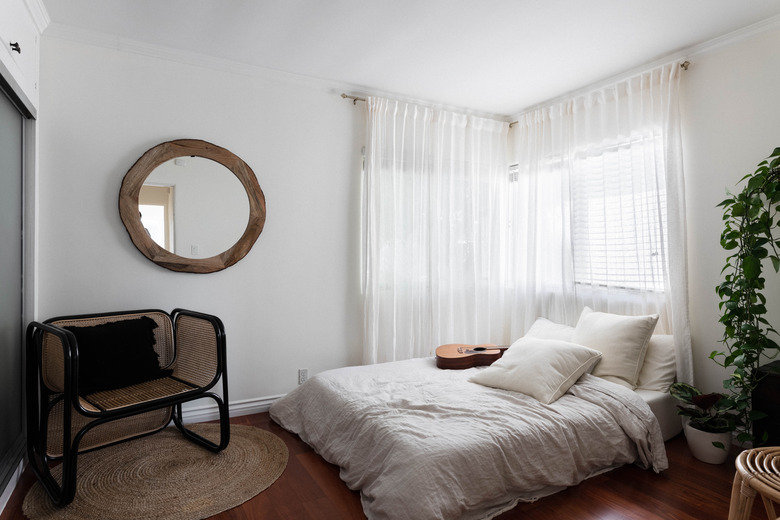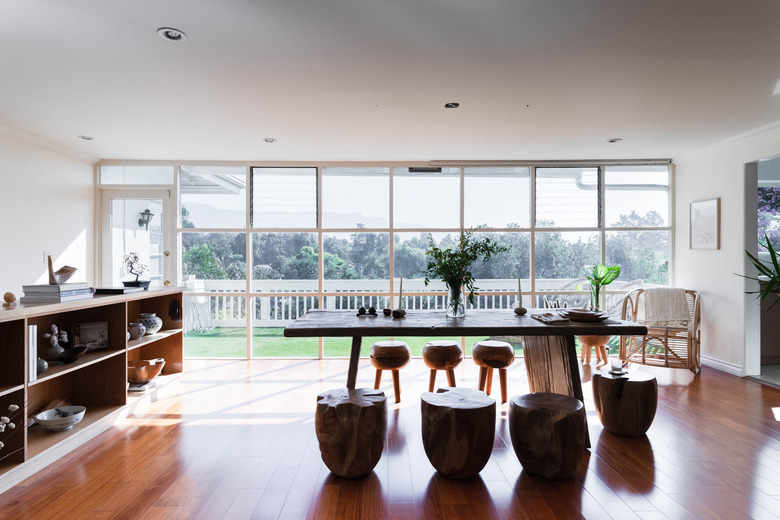Brazilian Cherry Flooring: A Homeowner's Guide
Brazilian cherry hardwood, also known as jatoba wood, has been popular since the early 2000s. This solid hardwood flooring is generally reddish-brown, which gives it its cherry name. It comes in all of the standard types of hardwood flooring, including both finished and unfinished solid planks and engineered forms. It makes an elegant addition to any home.
What Is Jatoba Wood?
What Is Jatoba Wood?
Jatoba is not real cherrywood. It comes from the wood species Hymenaea courbaril, which grows in southern Mexico, Central America, the northern part of South America and the West Indies. The heartwood of the tree has color variations from a light orange-brown to a deep reddish-brown and sometimes has contrasting streaks that are a deep brown with hints of gray. When exposed to light, the wood's overall color deepens.
According to the Wood Database, its grain tends to be medium to coarse, and it has a natural luster. It's durable and strong, which makes it perfect for flooring, but because of its density and hardness, it can be a challenging wood with which to work, as it can blunt tool cutters. Its interlocking grain is also difficult to plane. Nevertheless, it is easy to stain, glue, finish or bend by steam. Its strength makes it an excellent choice for those who are seeking high-quality, sturdy flooring.
Jatoba wood flooring is usually 3/4-inch thick but can come in a variety of thicknesses, lengths and widths. It can be cut into solid wood planks or can come as engineered wood and can be prefinished or unfinished.
Jatoba Wood Flooring Pros and Cons
Jatoba Wood Flooring Pros and Cons
Brazilian cherry hardwood is popular — its versatility, elegance and durability add investment value to both new and old homes. However, there are pros and cons you may want to consider before making a purchase. If you choose to go with this wood, make sure to get a slightly lighter shade, as it will darken over time.
Brazilian cherry hardwood is one of the sturdier woods on the market, with a hardness rating of 3,500 on the Janka hardness scale. This means it's exceptionally resistant to dents and other everyday hazards. It does well in high-traffic areas and, as a hard flooring material, it's a good option for allergy sufferers because it won't harbor dust and other allergens, like carpet can. Most types of this flooring are suitable to use with radiant (in-floor) heating systems.
While it is a high-priced wood upon initial purchase, its value to your home more than makes up for the cost. Brazilian cherry hardwood flooring can last 30 years or more with proper maintenance, and due to the strength and density of the wood, you can sand and refinish it multiple times, depending on the type of flooring. Solid hardwood typically can be sanded more times than engineered forms.
There are a few drawbacks to this exotic hardwood flooring, but they are minimal in comparison to the benefits. This wood is one of the more expensive woods on the market, and as with most dark-wood flooring, it does tend to show dust and dirt. Daily cleaning and vacuuming are necessary, as it will keep scratches to a minimum and prolong the life of the floor.
As with all wood flooring, Brazilian cherry is susceptible to damage from moisture, and it expands and contracts with changes in humidity. Water and liquid spills should be wiped up quickly to prevent the moisture from seeping between the floor boards, where it can do more damage. Engineered forms of Brazilian hardwood are generally more resistant to expansion and contraction that solid hardwood, due to their layered construction.
Prep for Brazilian Cherry Flooring Installation
Prep for Brazilian Cherry Flooring Installation
This hardwood flooring is known for its durability, and it's a good idea to consult a professional if you run into problems driving nails or getting clean cuts. If you're doing a large installation, have more than one saw blade on hand, because this wood dulls blades quickly.
Before installation, make sure you have plenty of materials with which to cover the floor. To do this, measure the room's square footage. After you know how much will cover the floor, add 10 percent more wood to your order, as you might need extra during the installation.
Let the wood acclimate by removing it from its packaging and letting it sit for 24 to 48 hours so that it settles into the temperature and humidity of your home. By doing this, you reduce the chances of the wood contracting or expanding after installation. Allowable moisture content is between 6 and 9 percent, so if moisture readings of the floorboards reveal a value over 9 percent, allow for additional acclimation time.
If you need to make adjustments to how your floor looks, make sure you do so before the actual installation. To do this, place the individual pieces on the floor. Shorter pieces in your wood bundles will not look good in the middle of the floor. Gather them together and install them in places where they are less likely to be seen, such as in a closet. After installation, exchanging or replacing floorboards is not an option.
Installing Brazilian Cherry Flooring
Installing Brazilian Cherry Flooring
Both engineered and solid Brazilian cherry flooring typically are nailed down to a plywood subfloor, usually over a layer or red rosin paper or tar paper (roofing felt). This layer provides a clean, dust-free surface for the flooring; it does not serve as a moisture barrier.
Once the floor boards are acclimated to the room, flooring installers lay out the boards and arrange them for best appearance, alternating the boards' lengths and selecting each for its color and grain patterns. A random arrangement with no detectable pattern looks best. For the installation, the boards are nailed to the subflooring, one row at a time, using a power flooring nailer or stapler.
If the flooring is prefinished, the final step is to install baseboard and other trimwork, as needed. No other finishing steps are required. For unfinished flooring, the newly installed boards are sanded, stained and finished on-site, following the traditional method of solid hardwood flooring installation. The finishing process can take three to seven days or more, depending on the type of finish used.
Cleaning and Care Tips
Cleaning and Care Tips
After installation is complete, use felt glides or pads on everything touching the floor to prevent damage. Do not roll heavy furniture or appliances over the floor. To move heavy items, put down 1/4-inch plywood or vinyl to protect the flooring.
To clean your Brazilian cherry floor, sweep or vacuum it frequently to remove dirt and grit that can scratch and dull the wood's finish. Mopping a wood floor is seldom necessary, but it's okay to wipe it with a microfiber mop or cloth slightly dampened with plain water. You can also use a hardwood flooring cleaner recommended by the flooring manufacturer or supplier. Do not wet-mop the floor, and do not use oily soaps, polishes, waxes or vinegar.

